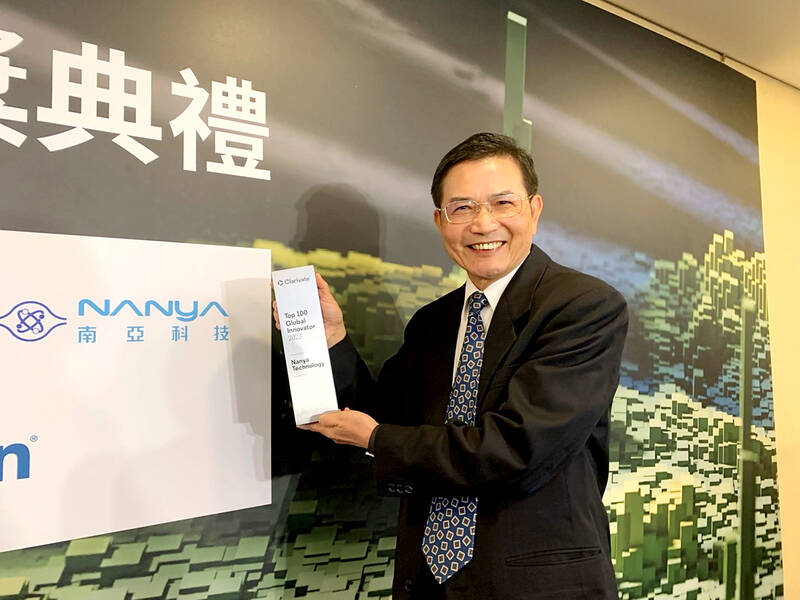DRAM chipmaker Nanya Technology Corp (南亞科技) plans to develop new high-bandwidth memory (HBM) chips tailor-made for edge artificial intelligence (AI) devices such as PCs, mobile phones and robots in an effort to differentiate itself from its rivals.
The HBM3, HBM4 and HBM2 used in AI servers are not the company’s target market, Nanya Technology president Lee Pei-ing (李培瑛) told reporters in Taipei yesterday.
The company’s focus is “customized” HBM products for edge AI devices, given its smaller capacity scale and limited resources, Lee said.

Photo: Grace Hung, Taipei Times
The company plans to roll out its first customized HBM product by the end of next year, in collaboration with chip designer Piecemakers Technology Inc (補丁科技) and chip packaging and testing service provider Formosa Advanced Technologies Co (福懋科技), he said.
Nanya Technology is also teaming up with a logic chip supplier to complete its HBM product, which stacks advanced DRAM chips on a small logic chip. Lee declined to disclose the name of the company’s logic chip partner.
“Under the current market situation, Nanya Technology is unlikely to compete with those chipmakers by capacity, cost efficiency or investment scale, especially those from China. The company needs to differentiate its products and to find its value when the world ushers in the AI era,” Lee said. “Customized HBM products are critical for Nanya Technology’s growth.”
The company aims to boost the contribution of DDR5 chips to about 30 percent of overall DRAM production this year. A majority of its DRAM capacity is for DDR4 chips.
Commenting on competition from a Chinese rival, Lee said the impact is “enormous” for the whole industry, not just on Nanya Technology.
“Without the huge capacity from that Chinese chipmaker, the low-power DDR4 and DDR5 market would have recovered,” he said.
With plentiful capital injection from the Chinese government, China’s Changxin Memory Technologies Inc (長鑫存儲) has become a major memory supplier in the world with capacity seven times bigger than Nanya Technology.
Lee said DRAM demand has improved since China launched new subsidy programs on electronics purchases last quarter.
He said the supply of DRAM chips for non-AI devices is dwindling, as major players such as SK Hynix Inc and Samsung Electronics Co are allocating more capacity for HBM chips used in servers.
Including Micron Technology Inc, the world’s top three producers’ inventory situation is also improving, he added.
These signs are positive for the industry, with a price rebound likely in the second half of this year, he said.
The company’s board of directors yesterday decided not to distribute cash a dividend this year, even though its losses shrank to NT$5.08 billion (US$154.9 million) last year from NT$7.44 billion in 2023.
The board approved capital expenditure of NT$19.6 billion this year to fund capacity buildup for its second-generation 10-nanometer-class process technology, denoting a process between 10-nanometers and 19-nanometers.

Taiwan will prioritize the development of silicon photonics by taking advantage of its strength in the semiconductor industry to build another shield to protect the local economy, National Development Council (NDC) Minister Paul Liu (劉鏡清) said yesterday. Speaking at a meeting of the legislature’s Economics Committee, Liu said Taiwan already has the artificial intelligence (AI) industry as a shield, after the semiconductor industry, to safeguard the country, and is looking at new unique fields to build more economic shields. While Taiwan will further strengthen its existing shields, over the longer term, the country is determined to focus on such potential segments as

UNCERTAINTY: Innolux activated a stringent supply chain management mechanism, as it did during the COVID-19 pandemic, to ensure optimal inventory levels for customers Flat-panel display makers AUO Corp (友達) and Innolux Corp (群創) yesterday said that about 12 to 20 percent of their display business is at risk of potential US tariffs and that they would relocate production or shipment destinations to mitigate the levies’ effects. US tariffs would have a direct impact of US$200 million on AUO’s revenue, company chairman Paul Peng (彭雙浪) told reporters on the sidelines of the Touch Taiwan trade show in Taipei yesterday. That would make up about 12 percent of the company’s overall revenue. To cope with the tariff uncertainty, AUO plans to allocate its production to manufacturing facilities in

COLLABORATION: Given Taiwan’s key position in global supply chains, the US firm is discussing strategies with local partners and clients to deal with global uncertainties Advanced Micro Devices Inc (AMD) yesterday said it is meeting with local ecosystem partners, including Taiwan Semiconductor Manufacturing Co (TSMC, 台積電), to discuss strategies, including long-term manufacturing, to navigate uncertainties such as US tariffs, as Taiwan occupies an important position in global supply chains. AMD chief executive officer Lisa Su (蘇姿丰) told reporters that Taiwan is an important part of the chip designer’s ecosystem and she is discussing with partners and customers in Taiwan to forge strong collaborations on different areas during this critical period. AMD has just become the first artificial-intelligence (AI) server chip customer of TSMC to utilize its advanced

While China’s leaders use their economic and political might to fight US President Donald Trump’s trade war “to the end,” its army of social media soldiers are embarking on a more humorous campaign online. Trump’s tariff blitz has seen Washington and Beijing impose eye-watering duties on imports from the other, fanning a standoff between the economic superpowers that has sparked global recession fears and sent markets into a tailspin. Trump says his policy is a response to years of being “ripped off” by other countries and aims to bring manufacturing to the US, forcing companies to employ US workers. However, China’s online warriors